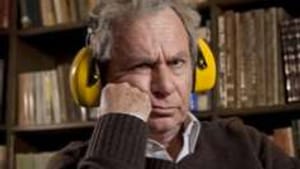Stay in the Loop
BSR publishes on a weekly schedule, with an email newsletter every Wednesday and Thursday morning. There’s no paywall, and subscribing is always free.
Pornography for bibliophiles, or: Footnotes for Footnote
Joseph Cedar's "Footnote' (1st review)

1. Footnote is the exceptional, engaging current Israeli film by Joseph Cedar that will be more than worthy of all the accolades it has already gained. It is— and I apologize for the list that follows— witty, poignant, inventive, allegorical, satirical-comical, Biblical, Oedipal, familial, nationalistic, ethnic, well-paced, well-acted, well-written, socially biting but understated, and intelligent, though with occasional images of chest hair. It praises and mocks: father and son relationships, academic narrow-mindedness, religious exegesis, journalistic meanness, bureaucratic incompetence, police state management, misguided prize-giving juries and lazy slacker children (apologies for this list as well).
The story, set in Jerusalem, is simple: Eleazer Shkolnik, a scholar in his 70s, has worked all his life on deciphering versions of the Talmud and has published several significant articles, but his work has been overlooked. He is bitter and feels neglected. His son Uriel is a dynamic contemporary Talmud scholar with a popular bent, whose work is dismissed as trivial by his father. When a committee decides to award the prestigious Israel Prize, a secretary confuses the names and the wrong Shkolnik is contacted.
Paper-cluttered desks
My point is that what attracts me to the film is less the deft handling of the Big Ideas it cogently dramatizes than the terrifically excessive mise en scène that shows, in crisp detail, overstuffed bookcases, packed library shelving, chaotically strewn book- and paper-cluttered desks and offices. Writing, books and acts of reading and arguing about books and publications and words and ideas are to Footnote what martial arts are to Jackie Chan movies.
In a few scenes, the elder Shkolnik peers into a microfiche machine that contains shadowy images of pages from the Talmud, the ancient Hebrew inked script on parchment, as mysterious as the folds in a museum case prayer shawl. Shkolnik sits shoulder-to-shoulder with other researchers. Books and notepads are piled everywhere.
There are also scenes where the father or son work in their home studies, library research rooms or in university offices where the floors and window nooks and space beneath chairs are crammed with stacks of journals, hardbound scholarly textbooks, and stapled manuscripts piled knee-high. When the son has to hide a letter, he climbs over a table heaped with enough books to stuff a duffel bag and reaches onto a window sill with layers of papers and magazines until he grabs a an old, unlikely to be noticed book. He tucks the letter in and buries it, satisfied— as if anyone would ever actually be able to locate an envelope in a book slipped beneath a handful of books accessible only after climbing over a mound of books and reaching for one on a window shelf of books.
Of course, there are those who would do just that: book lovers, librarians, antiquarian book dealers and certain species of scholar. Or, to put it another way: the movie is nearly pornography for bibliophiles.
Who would disagree?
2. Contemporary publishers, even of scholarly books and articles, discourage footnoting, which they consider costly and irrelevant. Some editors complain that authors add unnecessary comments in footnotes.
3. Jennifer Devere Brody in her enlightening Punctuation: Art, Politics and Play (Duke University Press, 2008), remarks, "Properly footnoted quotations are used to create a record of one's epistemological community" (page 114). There is no way to disagree with this statement.
4. Other references to footnotes in my work can be found in my catalog of the work of Philadelphia artist, Annson Kenney: Annson Kenney: Luminous Tubing. (Catalogue and Exhibition, Moore College of Art, 1983. 32 pages.)
5. A 28-page article I once wrote about the American composer Robert Ashley contains 41 footnotes. I think that's a lot.
6. What, you have a problem with that?
7. Ibid.
8. Armand Schwerner made the footnote into a singularly essential element in his long poem, The Tablets (Orono, Me.: National Poetry Foundation, 1999). Satirizing classical scholarship of ancient texts, he created a character called the Scholar-Translator, who was meshugenah when it came to footnotes. See my essay, "Armand Schwerner" in Dictionary of Literary Biography (Columbia, S.C.: Bruccoli, Clark, Layman, Inc., pp. 242-253).
9. With all due respect, it should have been obvious to Professor Kilman that Footloose is the name of a Hollywood movie. (What's with that guy?)
10. No one reads footnotes. And if you have read this far, I have only one thing to say: Get a life.♦
To read a response, click here.
To read another review by Robert Zaller, click here.
To read a related comment by Dan Rottenberg, click here.
The story, set in Jerusalem, is simple: Eleazer Shkolnik, a scholar in his 70s, has worked all his life on deciphering versions of the Talmud and has published several significant articles, but his work has been overlooked. He is bitter and feels neglected. His son Uriel is a dynamic contemporary Talmud scholar with a popular bent, whose work is dismissed as trivial by his father. When a committee decides to award the prestigious Israel Prize, a secretary confuses the names and the wrong Shkolnik is contacted.
Paper-cluttered desks
My point is that what attracts me to the film is less the deft handling of the Big Ideas it cogently dramatizes than the terrifically excessive mise en scène that shows, in crisp detail, overstuffed bookcases, packed library shelving, chaotically strewn book- and paper-cluttered desks and offices. Writing, books and acts of reading and arguing about books and publications and words and ideas are to Footnote what martial arts are to Jackie Chan movies.
In a few scenes, the elder Shkolnik peers into a microfiche machine that contains shadowy images of pages from the Talmud, the ancient Hebrew inked script on parchment, as mysterious as the folds in a museum case prayer shawl. Shkolnik sits shoulder-to-shoulder with other researchers. Books and notepads are piled everywhere.
There are also scenes where the father or son work in their home studies, library research rooms or in university offices where the floors and window nooks and space beneath chairs are crammed with stacks of journals, hardbound scholarly textbooks, and stapled manuscripts piled knee-high. When the son has to hide a letter, he climbs over a table heaped with enough books to stuff a duffel bag and reaches onto a window sill with layers of papers and magazines until he grabs a an old, unlikely to be noticed book. He tucks the letter in and buries it, satisfied— as if anyone would ever actually be able to locate an envelope in a book slipped beneath a handful of books accessible only after climbing over a mound of books and reaching for one on a window shelf of books.
Of course, there are those who would do just that: book lovers, librarians, antiquarian book dealers and certain species of scholar. Or, to put it another way: the movie is nearly pornography for bibliophiles.
Who would disagree?
2. Contemporary publishers, even of scholarly books and articles, discourage footnoting, which they consider costly and irrelevant. Some editors complain that authors add unnecessary comments in footnotes.
3. Jennifer Devere Brody in her enlightening Punctuation: Art, Politics and Play (Duke University Press, 2008), remarks, "Properly footnoted quotations are used to create a record of one's epistemological community" (page 114). There is no way to disagree with this statement.
4. Other references to footnotes in my work can be found in my catalog of the work of Philadelphia artist, Annson Kenney: Annson Kenney: Luminous Tubing. (Catalogue and Exhibition, Moore College of Art, 1983. 32 pages.)
5. A 28-page article I once wrote about the American composer Robert Ashley contains 41 footnotes. I think that's a lot.
6. What, you have a problem with that?
7. Ibid.
8. Armand Schwerner made the footnote into a singularly essential element in his long poem, The Tablets (Orono, Me.: National Poetry Foundation, 1999). Satirizing classical scholarship of ancient texts, he created a character called the Scholar-Translator, who was meshugenah when it came to footnotes. See my essay, "Armand Schwerner" in Dictionary of Literary Biography (Columbia, S.C.: Bruccoli, Clark, Layman, Inc., pp. 242-253).
9. With all due respect, it should have been obvious to Professor Kilman that Footloose is the name of a Hollywood movie. (What's with that guy?)
10. No one reads footnotes. And if you have read this far, I have only one thing to say: Get a life.♦
To read a response, click here.
To read another review by Robert Zaller, click here.
To read a related comment by Dan Rottenberg, click here.
What, When, Where
Footnote. A film directed by Joseph Cedar. At the Ritz Five, 220 Walnut St. and other Philadelphia venues. For show times, click here.
Sign up for our newsletter
All of the week's new articles, all in one place. Sign up for the free weekly BSR newsletters, and don't miss a conversation.

 AJ Sabatini
AJ Sabatini